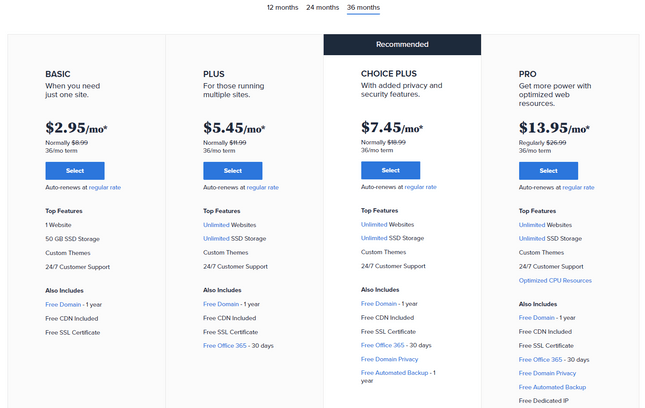Last updated on March 30th, 2025 at
| Feature | Bluehost | InMotion |
|---|---|---|
| ⭐ Rating | 4.5 | 4.3 |
| 💵 Price (from) | $1.99/month | $2.29/month |
| 📑 Uptime guarantee | 99.9% | 99.9% |
| 🔥 Coupons | Bluehost coupon 75% OFF! | InMotion Hosting coupon 75% OFF! |
| Storage space (from) | 10 GB SSD | 100 GB SSD |
| ✂️ Free domain (first year) | Yes | Yes (all but Core plan) |
| 🔒 Free SSL certificate | Yes (first year) | Yes |
| ➡️ Site migration | Free WordPress migration (1 site) or paid (up to 5 sites) | Free automated WordPress website transfers |
| 💾 Automated backups | Daily Website Backups (Free 1st year, not with Basic Plan) | For an extra fee |
| 📧 Email accounts | Free (up to 10 accounts) | Free (up to 10 accounts) |
| 👨💻 24/7 live support | Yes | Yes |
| 💰 Money-back guarantee | 30-day
| 90-day
|
Plan and Pricing
Bluehost Plans
| Plan | Price | Websites | Storage | Ideal For |
|---|---|---|---|---|
| Bluehost Basic | $2.95/mo (Save 75%) | 1 | 10 GB SSD | Single website |
| Bluehost Plus | $4.95/mo (Save 71%) | Unlimited | 20 GB SSD | Multiple websites |
| Bluehost Choice Plus | $5.45/mo (Save 75%) | Unlimited | 50 GB SSD | Additional privacy & security |
| Bluehost Pro | $13.95/mo (Save 52%) | Unlimited | 100 GB SSD | More speed & processing power |

Basic
Price: $2.95/mo (Save 75%)
Ideal for: Single website
Features:
- 1 Website
- Free Domain for 1st Year
- Free SSL
- Free CDN Enabled
- ~15k Visits Per Month
- 10 GB SSD Storage
- 3 Months Free Pro Email Trial
- Free WP Migration Tool
- 24/7 Chat Support
Plus
Price: $4.95/mo (Save 71%)
Ideal for: Multiple websites
Features:
- Unlimited Websites
- Free Domain for 1st Year
- Free SSL
- Free CDN Enabled
- ~50k Visits Per Month
- 20 GB SSD Storage
- 3 Months Free Pro Email Trial
- Free WP Migration Tool
- 24/7 Chat Support
Choice Plus
Price: $5.45/mo (Save 75%)
Ideal for: Additional privacy and security
Features:
- Unlimited Websites
- Free Domain for 1st Year
- Free SSL
- Free CDN Enabled
- ~200k Visits Per Month
- 50 GB SSD Storage
- 3 Months Free Pro Email Trial
- Free WP Migration Tool
- 24/7 Chat Support
Pro
Price: $13.95/mo (Save 52%)
Ideal for: More speed and processing power
Features:
- Unlimited Websites
- Free Domain for 1st Year
- Free SSL
- Free CDN Enabled
- ~400k Visits Per Month
- 100 GB SSD Storage
- 3 Months Free Pro Email Trial
- Free WP Migration Tool
- 24/7 Chat Support
InMotion Hosting Plans
| Plan | Price | Websites | Storage | Ideal For |
|---|---|---|---|---|
| InMotion Core Plan | $2.99/mo | 2 | 100 GB SSD | Simple sites |
| InMotion Launch Plan | $4.79/mo | 25 | Unlimited NVMe SSD | Multi-site management |
| InMotion Power Plan | $4.79/mo | Unlimited | Unlimited NVMe SSD | Larger sites |
| InMotion Pro Plan | $10.79/mo | Unlimited | Unlimited NVMe SSD | High-traffic or eCommerce |
Core Plan
- Price: $2.99/mo (Renews at $10.99/mo)
- Ideal for: Simple sites
- Features:
- Free domain & SSL
- 2 Websites
- 100GB SSD
- Unlimited Bandwidth
- 2x Speed & Performance
- 10 Email Addresses
- Security Suite
- Marketing Tools
- Python, Node.JS, Ruby, GIT
- Choice of Data Center Location (US and EU)
- Live Chat Support
Launch Plan
- Price: $4.79/mo (Renews at $13.99/mo)
- Ideal for: Multi-site management
- Features:
- Free domain & SSL
- 25 Websites
- Unlimited NVMe SSD
- Unlimited Bandwidth
- 6x UltraStack Speed & Performance
- Unlimited Email Addresses
- Security Suite
- Marketing Tools
- Python, Node.JS, Ruby, GIT
- Choice of Data Center Location
- Pro Support SLA
- Live Chat Support
Power Plan
- Price: $4.79/mo (Renews at $17.99/mo)
- Ideal for: Larger sites & managing clients
- Features:
- Free domain & SSL
- Unlimited Websites
- Unlimited NVMe SSD
- Unlimited Bandwidth
- 12x UltraStack Speed & Performance
- Unlimited Email Addresses
- Security Suite
- Advanced Caching
- Marketing Tools
- Python, Node.JS, Ruby, GIT
- Choice of Data Center Location
- Pro Support SLA
- Live Phone and Chat Support
Pro Plan
- Price: $10.79/mo (Renews at $24.99/mo)
- Ideal for: High-traffic or eCommerce sites
- Features:
- Free domain & SSL
- Unlimited Websites
- Unlimited NVMe SSD
- Unlimited Bandwidth
- 20x UltraStack Speed & Performance
- Unlimited Email Addresses
- Security Suite
- Advanced Caching
- Marketing Tools
- Python, Node.JS, Ruby, GIT
- Choice of Data Center Location
- Pro Support SLA
- Dedicated IP
- Live Phone and Chat Support








